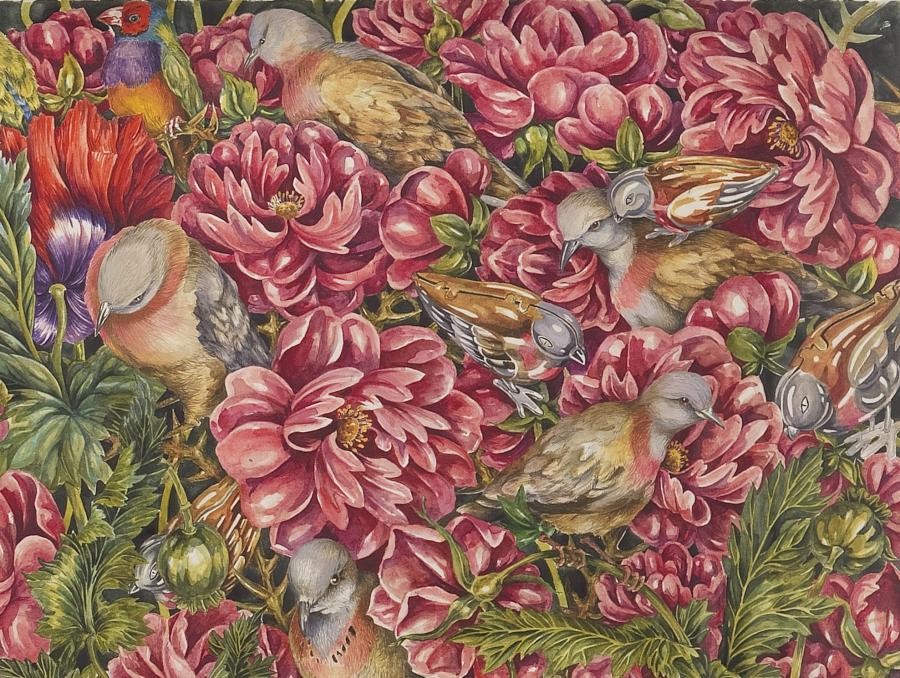Cure for Pain Part 3: Birds

Cure for Pain by eX de Medici.
ART96843
Cure for pain is an exploration of Australia’s military history. Measuring just over four metres in length, it would be easy to be seduced by the beauty and skill of this watercolour, yet the symbols of birds, flowers and helmets mask uncomfortable stories. Birds feature in Cure for pain as symbols of country, communication, and surveillance, representing what the artist terms “spies”. Interspersed among the flowers and helmets are these spies: Australian Gouldian finches, a zebra finch, a firetail finch, nightingales and Iranian pigeons. From the First and Second World Wars, the work also features French, Australian, and Japanese carrier pigeons that the artist studied in the Memorial’s collection. An Australian Blue Chequer cock pigeon – perhaps another spy – is perched atop a flying helmet, wearing the Victoria Cross. There is a medal for valour in animals, the Dickin Medal; but this bird has been awarded a VC.
Ornithologist John Gould named the Gouldian finch, with its rich purple and yellow plumage, after his wife, the natural history illustrator Elizabeth Gould. When she was eight years old, de Medici visited an antiquarian bookshop, where she was first introduced to the work of Elizabeth Gould through the lithographic publication The birds of Australia. Although the book was created in partnership with her husband, over the years Elizabeth’s vast contribution has never received the same level of acknowledgement as her husband’s. This lack of recognition stuck with de Medici, forming part of her motivation for the inclusion of the Gouldian finch in Cure for pain.
Iran is a major point of reference in the painting. The nightingales and pigeons refer to de Medici’s travels to Iran, a country she visited five times during 2009–13. There, in Isfahan, de Medici photographed the nightingale, famous for its song: but the caged male nightingale sings only when it has no mate. The Iranian roses and nightingales in the painting were inspired by a visit to the Vakil Mosque in Shiraz, Iran, but they also reflect de Medici’s interest in the literature of Sufism. The Iranian roses, growing among the Australian helmets, suggest a strained relationship. At the time de Medici was making Cure for pain, Australia was imposing sanctions against Iranian individuals and organisations in response to Iran’s nuclear program. The topic is explored in Shahram Akbarzadeh’s 2013 paper, “Australia’s relations with Iran”.

Cure for Pain by eX de Medici.
ART96843
In a reference to the ways in which the military adapt the natural world to the technological world, de Medici has also included little mechanical tin birds that look like a child’s toy. Rather than being innocent playthings, these mechanical birds – cyborgs or perhaps drones – operate as spies and as carriers of messages. There are several mechanical birds with the colouring of Iranian pigeons, distinguished by their pink throats. One mechanical bird sits in the bottom centre of the image, and is rendered in a geometric pattern, using the colour range of Australian Defence Force digital camouflage; this bird has a pink ribbon tied around its leg. The pink ribbon is a symbol of the democratic Green Movement in Iran, where in 2009 protesters rallied against the election of Mahmoud Ahmadinejad. De Medici had a friend who was a human rights lawyer in Iran, and an anti-fascist protester during the 2009 election. There was great suspicion that using social media was not secure; and de Medici recalls telling this friend, “You should use a carrier pigeon.” This same friend told de Medici of Facebook handing over the names of 10,000 protestors to the Ahmadinejad presidency, who were then interred in the feared Evin Prison in Tehran. In a digital age of rapid dissemination of information, de Medici argues for being suspicious about who is controlling that information, and how it may be used.
Cure for pain by eX de Medici was generously gifted to the Memorial, through the Australian Government’s Cultural Gifts Program, by Erika Krebs-Woodward in 2016. Cure for pain is on display in the exhibition The deceiving eye, located on the Mezzanine Gallery of Anzac Hall, until 22 October 2017.